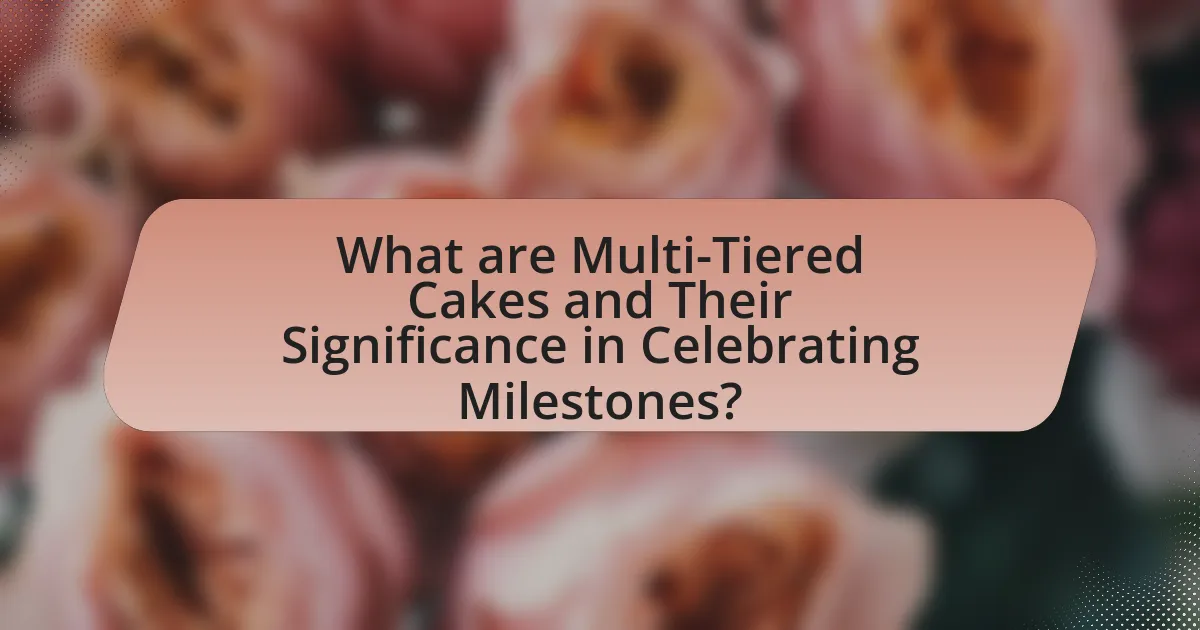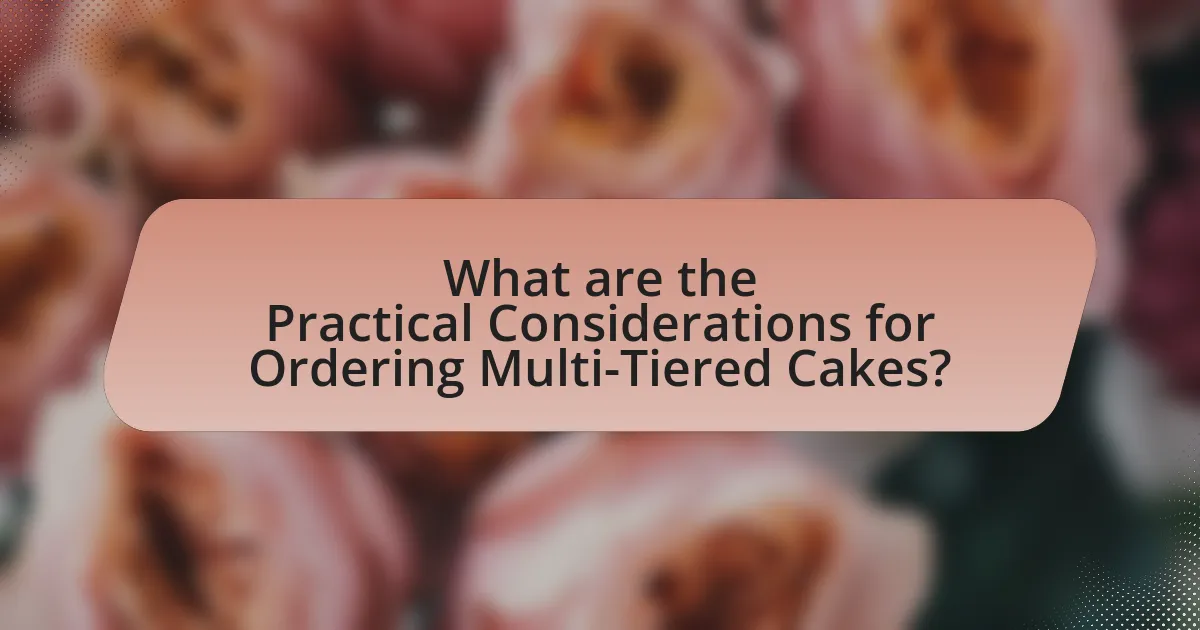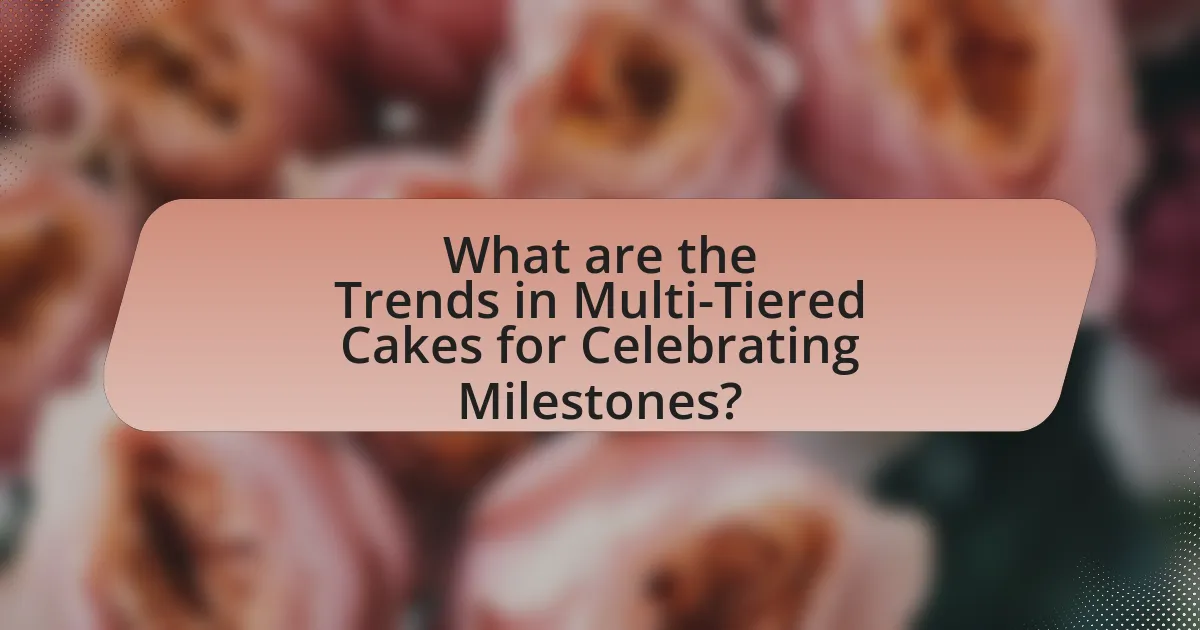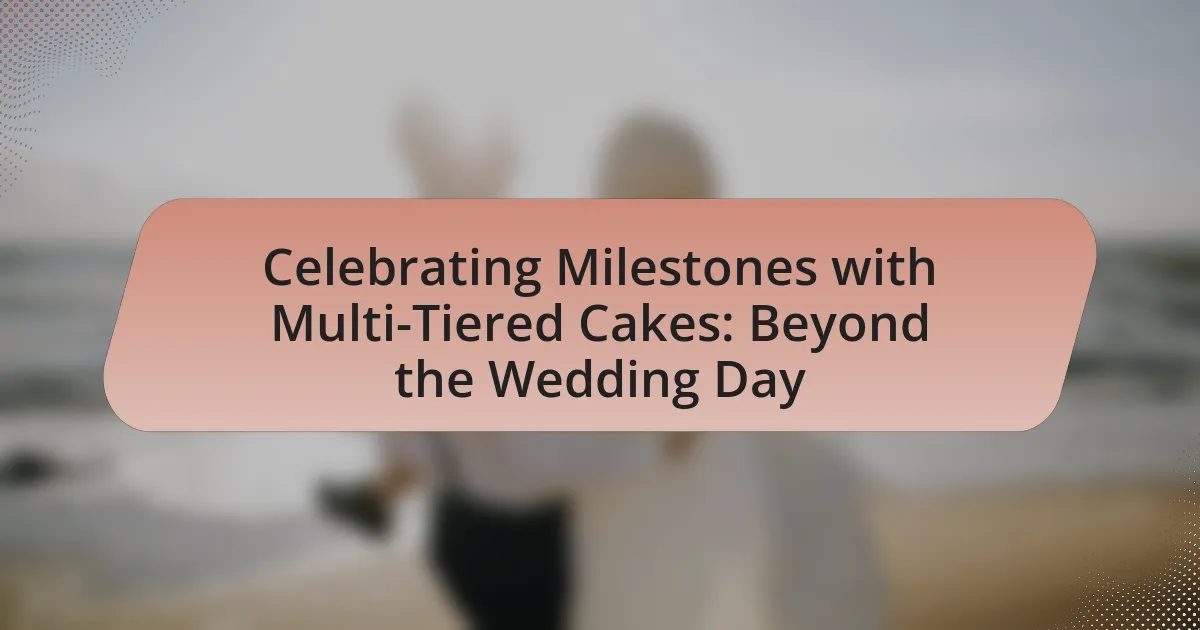Multi-tiered cakes are elaborate desserts commonly used to celebrate significant milestones such as weddings, birthdays, and anniversaries. Their design features multiple stacked layers, symbolizing celebration and abundance, and they differ from regular cakes in structure and complexity. The article explores the significance of multi-tiered cakes, their historical context, key features, and the various occasions they commemorate. It also discusses customization options, popular themes, flavor trends, and practical considerations for ordering and serving these cakes, highlighting their role in creating memorable experiences during life’s important events.

What are Multi-Tiered Cakes and Their Significance in Celebrating Milestones?
Multi-tiered cakes are elaborate cakes consisting of multiple stacked layers, often used to commemorate significant events such as weddings, birthdays, and anniversaries. Their significance lies in their visual impact and symbolic representation of celebration, unity, and abundance. Historically, multi-tiered cakes have been associated with grandeur and festivity, with the tradition dating back to ancient Roman times when cakes were stacked to symbolize prosperity. The complexity and artistry involved in creating these cakes also reflect the importance of the occasion being celebrated, making them a focal point at milestone events.
How do Multi-Tiered Cakes differ from Regular Cakes?
Multi-tiered cakes differ from regular cakes primarily in their structure and design, as multi-tiered cakes consist of multiple stacked layers, while regular cakes typically feature a single layer. The multi-tiered design allows for greater height and visual impact, making them ideal for significant celebrations such as weddings and milestone events. Additionally, multi-tiered cakes often require more intricate construction techniques, including support systems like dowels or plates to ensure stability, which is not necessary for regular cakes. This complexity in design and construction underscores the unique nature of multi-tiered cakes in celebratory contexts.
What are the key features of Multi-Tiered Cakes?
Multi-tiered cakes are characterized by their multiple layers, which create a visually striking and impressive presentation. These cakes often feature distinct flavors and fillings in each tier, allowing for a variety of taste experiences. Additionally, multi-tiered cakes are typically supported by dowels or other structural elements to ensure stability, especially when serving large gatherings. The decoration of these cakes can be elaborate, incorporating fondant, buttercream, and intricate designs that reflect the theme of the celebration. Statistically, multi-tiered cakes are commonly used for significant events such as weddings, anniversaries, and milestone birthdays, highlighting their importance in celebratory contexts.
Why are Multi-Tiered Cakes preferred for special occasions?
Multi-tiered cakes are preferred for special occasions because they symbolize celebration and grandeur. Their elaborate design allows for customization, catering to various themes and personal preferences, making them visually striking centerpieces. Additionally, multi-tiered cakes can serve a larger number of guests, which is essential for events like weddings, anniversaries, and milestone birthdays. The tradition of using multi-tiered cakes dates back to the Victorian era, where they represented wealth and status, further solidifying their association with significant life events.
What milestones are commonly celebrated with Multi-Tiered Cakes?
Multi-tiered cakes are commonly celebrated for significant milestones such as weddings, anniversaries, birthdays, and graduations. Weddings often feature elaborate multi-tiered cakes as a centerpiece, symbolizing the couple’s union. Anniversaries, particularly milestone years like the 25th or 50th, also utilize these cakes to commemorate enduring love. Birthdays, especially for children and adults marking significant ages like 1, 16, 18, or 21, frequently include multi-tiered designs to enhance the celebration. Graduations are another occasion where multi-tiered cakes are used, often decorated with themes reflecting the graduate’s achievements. These celebrations highlight the importance of the events and the desire to create memorable experiences.
How do birthdays influence the design of Multi-Tiered Cakes?
Birthdays significantly influence the design of multi-tiered cakes by dictating themes, flavors, and decorations that reflect the celebrant’s personality and preferences. For instance, a child’s birthday cake may feature vibrant colors and popular characters, while an adult’s cake might incorporate sophisticated designs and flavors like chocolate or red velvet. The customization of multi-tiered cakes for birthdays often includes elements such as age-specific decorations, personalized messages, and unique shapes that resonate with the individual being celebrated. This trend is supported by the growing popularity of themed birthday parties, which has led to an increase in demand for visually striking and personalized cakes that enhance the overall celebration experience.
What role do anniversaries play in the selection of cake styles?
Anniversaries significantly influence the selection of cake styles by reflecting the couple’s journey and the milestone being celebrated. For instance, a 25th anniversary, known as a silver anniversary, often features silver accents and elegant designs, while a 50th anniversary, or golden anniversary, typically showcases gold elements and luxurious decorations. These choices are rooted in tradition, where specific materials and colors symbolize the years spent together, thus guiding cake designers in creating personalized and meaningful cakes that resonate with the couple’s history and the significance of the occasion.
Why is the Wedding Day often associated with Multi-Tiered Cakes?
The Wedding Day is often associated with multi-tiered cakes because they symbolize prosperity, abundance, and the couple’s new life together. Historically, multi-tiered cakes originated in the Victorian era, where they represented the couple’s social status and wealth, as larger cakes were more expensive and extravagant. Additionally, the tradition of stacking cakes dates back to ancient Rome, where guests would bring small cakes to the wedding, and the couple would attempt to kiss over a pile of them, symbolizing good fortune. This practice evolved into the modern multi-tiered wedding cake, which has become a central element of wedding celebrations, reflecting both the significance of the occasion and the couple’s commitment to each other.
What traditions surround the use of Multi-Tiered Cakes at weddings?
Multi-tiered cakes are a traditional centerpiece at weddings, symbolizing prosperity and the couple’s shared future. Historically, the height of the cake represents the couple’s aspirations and the layers signify their journey together, with each tier often reflecting different flavors or styles to cater to diverse guests. Additionally, the act of cutting the cake together is a significant ritual, representing the couple’s first task as partners and their commitment to share their lives. This tradition has roots in ancient Roman customs, where cake was broken over the bride’s head to bring good fortune.
How do wedding cake designs reflect personal stories?
Wedding cake designs reflect personal stories by incorporating elements that symbolize the couple’s journey, values, and shared experiences. For instance, a couple may choose specific colors, flavors, or motifs that represent their cultural backgrounds or significant moments in their relationship, such as their first date or a shared hobby. This personalization is often evident in the cake’s decoration, which can include custom figurines, floral arrangements, or inscriptions that convey meaningful messages. Research indicates that 70% of couples opt for unique designs that tell their story, highlighting the importance of personalization in wedding celebrations.
How can Multi-Tiered Cakes be customized for various celebrations?
Multi-tiered cakes can be customized for various celebrations by altering their design, flavor, and decoration to suit the specific event. For instance, a birthday cake may feature vibrant colors and themed decorations, while a graduation cake might incorporate elements like the school colors and graduation caps. Additionally, flavors can be tailored to the preferences of the celebrant, such as chocolate for a birthday or vanilla for a wedding. Customization can also include personalized messages or images that reflect the occasion, ensuring that the cake aligns with the celebration’s theme and significance.
What are the popular themes for Multi-Tiered Cakes beyond weddings?
Popular themes for multi-tiered cakes beyond weddings include birthdays, anniversaries, baby showers, graduations, and holidays. Each of these occasions often features specific designs and decorations that reflect the celebratory nature of the event. For instance, birthday cakes may incorporate themes based on favorite characters or hobbies, while anniversary cakes often symbolize the couple’s journey together. Baby shower cakes typically showcase pastel colors and baby-related motifs, and graduation cakes frequently highlight school colors and achievements. Holiday-themed cakes, such as those for Christmas or Halloween, utilize seasonal decorations and flavors. These themes are widely recognized and cater to the diverse celebrations in people’s lives.
How can flavors and fillings be tailored to suit different occasions?
Flavors and fillings can be tailored to suit different occasions by selecting combinations that reflect the theme and preferences of the event. For instance, a rich chocolate ganache may be ideal for a birthday celebration, while a light lemon or vanilla filling could be more appropriate for a spring wedding. Seasonal ingredients can also enhance the relevance of the cake; for example, pumpkin spice flavors are popular in autumn, while fresh berries are favored in summer. Additionally, cultural preferences can guide flavor choices, such as using red bean paste for Asian celebrations or fruitcake for traditional holiday gatherings. These tailored selections ensure that the cake complements the occasion and resonates with the guests.

What are the Practical Considerations for Ordering Multi-Tiered Cakes?
When ordering multi-tiered cakes, practical considerations include size, flavor, design, and delivery logistics. The size must accommodate the number of guests, with each tier typically serving a specific number of people; for example, a standard tier can serve 10-15 guests. Flavor selection is crucial, as it should appeal to a diverse audience, often requiring a combination of popular options like chocolate, vanilla, and red velvet. Design elements should reflect the occasion, incorporating themes or colors relevant to the celebration, which may require consultation with a cake designer for feasibility. Delivery logistics are essential, as multi-tiered cakes are delicate and may require special transportation arrangements to prevent damage. These considerations ensure that the cake meets both aesthetic and functional needs for the event.
How do you choose the right bakery for a Multi-Tiered Cake?
To choose the right bakery for a multi-tiered cake, evaluate the bakery’s portfolio and customer reviews. A bakery with a diverse portfolio demonstrates experience in creating intricate designs and flavors, which is essential for multi-tiered cakes. Customer reviews provide insights into the bakery’s reliability, taste, and service quality. Additionally, consider scheduling a consultation to discuss your specific needs and preferences, ensuring the bakery can accommodate your vision. This approach is supported by the fact that successful bakeries often showcase their best work online, allowing potential customers to assess their capabilities before making a decision.
What questions should you ask a baker before placing an order?
Before placing an order with a baker, you should ask about their experience with multi-tiered cakes, including how many they have made and if they have a portfolio of previous work. This is crucial because a baker’s experience directly impacts the quality and design of the cake. Additionally, inquire about flavor options, dietary restrictions, and whether they can accommodate specific themes or designs. Confirm their availability for your event date and ask about delivery and setup services, as these factors can affect the overall success of your celebration. Lastly, request a detailed quote that includes pricing for different tiers and any additional costs for custom decorations or ingredients.
How can you ensure the cake meets your expectations?
To ensure the cake meets your expectations, clearly communicate your preferences and requirements to the baker. Providing specific details such as flavor, design, size, and any dietary restrictions will help the baker understand your vision. Research shows that effective communication reduces misunderstandings and increases satisfaction in custom cake orders, as highlighted in a study by the American Bakers Association, which emphasizes the importance of detailed consultations in achieving desired outcomes.
What factors influence the cost of Multi-Tiered Cakes?
The cost of multi-tiered cakes is influenced by several key factors, including the complexity of the design, the quality of ingredients, and the level of customization required. Complex designs, such as intricate decorations or unique shapes, require more time and skill, which increases labor costs. High-quality ingredients, such as premium chocolate or organic flour, also raise the overall price due to their higher market value. Additionally, customization, such as personalized flavors or specific themes, adds to the cost as it often involves more detailed planning and execution. These factors collectively determine the final price of a multi-tiered cake.
How do ingredients and design complexity affect pricing?
Ingredients and design complexity significantly influence pricing in multi-tiered cakes. High-quality ingredients, such as premium chocolate or organic fruits, increase production costs, leading to higher retail prices. For instance, cakes made with artisanal butter or specialty flour can cost 20-30% more than those made with standard ingredients. Additionally, intricate designs require more time and skill, which translates to higher labor costs. A cake featuring detailed fondant work or multiple tiers may take several hours to create, justifying a price increase of 50% or more compared to simpler designs. Therefore, both the choice of ingredients and the complexity of the design directly correlate with the final price of the cake.
What are some budget-friendly alternatives for Multi-Tiered Cakes?
Budget-friendly alternatives for multi-tiered cakes include sheet cakes, cupcakes, and cake pops. Sheet cakes can be made in larger sizes to serve many guests while maintaining a simple design, significantly reducing costs compared to tiered cakes. Cupcakes offer individual servings and can be arranged in a tiered display, providing a similar visual effect without the expense of multiple cake layers. Cake pops are another economical option, allowing for creative decoration and easy serving, while also being less costly to produce than traditional multi-tiered cakes. These alternatives effectively meet the needs of celebrations while being mindful of budget constraints.
How should you plan for the logistics of serving a Multi-Tiered Cake?
To plan for the logistics of serving a multi-tiered cake, first ensure that the cake is structurally sound and properly supported with dowels or cake boards between tiers. This prevents collapse during transportation and serving. Next, determine the serving size by calculating the number of guests and the cake’s dimensions, as a standard slice from a multi-tiered cake typically serves 1 to 2 people depending on the size of the slice.
Additionally, coordinate the timing of the cake cutting with the event schedule to ensure it is served at the optimal moment, often after speeches or toasts. Prepare the serving area with necessary tools such as a sharp knife, cake server, and plates, and consider the layout to facilitate easy access for guests. Finally, if the cake requires refrigeration, plan for a suitable storage solution until serving time, as many multi-tiered cakes contain perishable fillings or frostings.
What are the best practices for transporting a Multi-Tiered Cake?
The best practices for transporting a multi-tiered cake include securing the cake on a sturdy, flat surface, using cake boxes or carriers designed for tiered cakes, and ensuring that each tier is properly supported with dowels or cake boards. Properly securing the cake prevents movement during transport, which can lead to damage. Additionally, it is essential to keep the cake at a stable temperature to avoid melting or structural failure, particularly if the cake contains perishable ingredients. Using non-slip mats can also help stabilize the cake during transit. These practices are crucial to maintain the cake’s integrity and presentation, ensuring it arrives at its destination in perfect condition.
How can you ensure the cake stays fresh until the event?
To ensure the cake stays fresh until the event, store it in a cool, dry place, ideally in an airtight container. This method prevents moisture loss and protects the cake from external odors and contaminants. Additionally, if the cake is frosted, refrigerating it can help maintain its freshness, as long as it is properly covered to avoid drying out. Research indicates that cakes can remain fresh for several days when stored correctly, with refrigeration extending their shelf life by slowing down the growth of bacteria and mold.

What are the Trends in Multi-Tiered Cakes for Celebrating Milestones?
Trends in multi-tiered cakes for celebrating milestones include personalized designs, unique flavor combinations, and sustainable ingredients. Personalized designs often reflect the individual’s personality or the theme of the celebration, such as incorporating specific colors, motifs, or even photographs. Unique flavor combinations, such as lavender lemon or chocolate raspberry, cater to diverse palates and enhance the overall experience. Additionally, the use of sustainable ingredients, including organic and locally sourced products, aligns with the growing consumer preference for environmentally friendly options. These trends are supported by market research indicating a shift towards customization and sustainability in the food industry, particularly in celebratory contexts.
How are modern designs changing the landscape of Multi-Tiered Cakes?
Modern designs are transforming the landscape of multi-tiered cakes by incorporating innovative aesthetics, diverse flavor profiles, and personalized themes. These contemporary approaches allow for greater creativity, as bakers utilize techniques such as geometric shapes, metallic finishes, and intricate sugar art to create visually stunning cakes that cater to individual preferences. For instance, the rise of non-traditional flavors like lavender or matcha reflects a shift towards unique culinary experiences, appealing to a broader audience beyond classic vanilla or chocolate. Additionally, the trend of customizing cakes for various celebrations, such as birthdays or anniversaries, emphasizes personal storytelling through design, making each cake a unique centerpiece. This evolution in cake design not only enhances the visual appeal but also elevates the overall experience of milestone celebrations.
What innovative techniques are being used in cake decoration?
Innovative techniques in cake decoration include the use of edible 3D printing, airbrushing, and mirror glazing. Edible 3D printing allows for intricate designs and personalized decorations that were previously difficult to achieve, enhancing the visual appeal of multi-tiered cakes. Airbrushing techniques enable decorators to create gradients and detailed patterns with precision, adding depth and dimension to the cake’s surface. Mirror glazing provides a glossy finish that reflects light beautifully, making cakes visually striking and appealing for milestone celebrations. These techniques are transforming traditional cake decoration into a more artistic and customizable experience.
How do cultural influences shape cake trends?
Cultural influences shape cake trends by dictating flavors, designs, and presentation styles that reflect societal values and traditions. For instance, in many Western cultures, wedding cakes are often multi-tiered and white, symbolizing purity and celebration, while in other cultures, such as in India, cakes may incorporate vibrant colors and flavors like cardamom or saffron, reflecting local tastes and customs. Additionally, cultural events, such as birthdays or holidays, often inspire specific cake designs, like the use of traditional motifs or ingredients that resonate with particular communities. This interplay between culture and cake trends illustrates how societal norms and preferences directly impact the evolution of cake styles and flavors.
What are the most popular flavors and fillings for Multi-Tiered Cakes today?
The most popular flavors for multi-tiered cakes today include vanilla, chocolate, red velvet, and lemon. These flavors are favored for their broad appeal and versatility in pairing with various fillings. Common fillings that complement these flavors are buttercream, cream cheese, ganache, and fruit preserves. The popularity of these flavors and fillings is supported by trends in cake design and consumer preferences, with vanilla and chocolate consistently ranking as top choices in surveys conducted by baking industry experts.
How do flavor trends evolve with changing consumer preferences?
Flavor trends evolve with changing consumer preferences through a dynamic interplay of cultural influences, health consciousness, and innovation in food technology. As consumers increasingly seek unique and diverse flavor experiences, trends shift towards exotic ingredients and bold combinations, reflecting a desire for personalization and exploration in culinary choices. For instance, the rise of plant-based diets has led to an increased popularity of flavors derived from fruits, herbs, and spices that cater to health-oriented consumers. Additionally, market research indicates that 60% of consumers are more likely to try new flavors that align with their dietary preferences, showcasing a direct correlation between consumer behavior and flavor innovation.
What unique combinations are gaining popularity among celebrants?
Unique combinations gaining popularity among celebrants include multi-tiered cakes paired with personalized themes, such as combining traditional flavors with modern designs. For instance, celebrants are increasingly opting for flavors like lavender and lemon or chocolate and raspberry, which enhance the visual appeal and taste experience. This trend is supported by data from cake industry surveys indicating a 30% increase in demand for unique flavor pairings in celebratory events over the past two years.
What tips can help you create the perfect Multi-Tiered Cake experience?
To create the perfect multi-tiered cake experience, ensure proper structural support by using dowels or cake boards between tiers. This technique prevents the cake from collapsing under its own weight, which is crucial for maintaining stability during transport and display. Additionally, choose complementary flavors and fillings for each tier to enhance the overall taste experience, as diverse flavors can cater to different preferences among guests. Finally, pay attention to the decoration; using a cohesive color scheme and theme that aligns with the occasion will elevate the visual appeal, making the cake a centerpiece that reflects the celebration’s significance.
How can you effectively communicate your vision to the baker?
To effectively communicate your vision to the baker, clearly articulate your ideas, preferences, and expectations regarding the cake design, flavors, and overall theme. Providing visual references, such as images of cakes that inspire you, helps convey your aesthetic preferences and desired style. Additionally, discussing specific details like size, color palette, and any special elements, such as decorations or inscriptions, ensures that the baker understands your vision comprehensively. This approach aligns with best practices in collaborative projects, where clear communication enhances the final outcome.
What are the essential elements to consider for a successful cake presentation?
The essential elements to consider for a successful cake presentation include visual appeal, proper serving techniques, and thematic consistency. Visual appeal is achieved through the use of color, decoration, and cake design, which should attract attention and complement the event’s theme. Proper serving techniques involve ensuring the cake is cut and served in a manner that maintains its structure and aesthetic, often using appropriate tools and methods. Thematic consistency ensures that the cake aligns with the overall decor and purpose of the celebration, enhancing the event’s atmosphere. These elements collectively contribute to a memorable cake presentation that enhances the celebratory experience.
